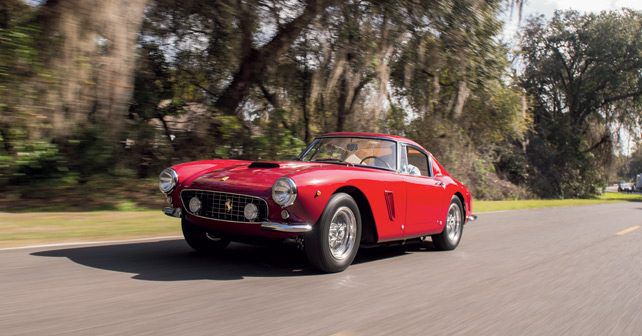This 1961 Ferrari 250 GT SWB (short wheelbase) is one of the most desirable cars ever made. Here’s a detailed account on what makes it so special, and so frightfully expensive…
Let’s put it this way – loving a Ferrari isn’t necessary, it just happens automatically. Agreed, not everyone loves all Ferraris, but it’s impossible for anyone not to be mesmerised by the charm of the classic GT cars from Maranello. A case in point is the 250 GT SWB – a classic among classics! Yes, the very car that you see in these pictures. However, if you wish this specimen to be yours, you may well be in for a bit of a shock. It was recently on auction at Amelia Island by RM Sotheby’s, but because the reserve price was set at 9 million Euros it didn’t find any takers on this occasion. Looking at its value historically though, 9 million isn’t an unreasonable sum for a car of this nature. That’s just the kind of crazy values that these cars command.
Light, but not the lightest
The specimen that you see here is the road-going version of the 250 SWB. Naturally, it’s been toned down from the racing version. This one actually has bumpers and a liveable cabin. But, most importantly, it uses different materials in its body construction. The hood and doors are made of aluminium, while the rest of the body is made of steel – meaning it’s not as light as the Competizione (racing) models. Only 176 pieces of the SWB Scaglietti were produced in total. This particular specimen is chassis no. 2639, and its first owner was Marion Dall’Orso from Genoa. He owned it for a short time, after which the car ended up in the US. It changed hands many times thereafter – primarily in California and Texas. It came back to Europe in the 80’s, but was soon sent to the US again – where, between 2011 and 2015, it was restored by renowned atelier, Motion Products of Neenah, in Wisconsin. After the restoration work had been done, ‘2639’ went on to win numerous awards, including “Best of Show” at the Italian Monterey Competition, the “Platinum Award” of the Ferrari Club of America and the “Cavallino Classic” award in Florida. In fact, it was recognised by Ferrari Classic for its impeccable restoration.
Discs at all corners
This year marks the 70th anniversary of Ferrari, so to treat ourselves in the best way possible we got to take a ride in this “holy grail” of a Prancing Horse. It looked scintillating even while standing still in the parking lot. In fact, just imagining this thing in motion gives one goose bumps. Even though we couldn’t floor the 250 SWB right out of the parking lot, we craved to hear the sound of the glorious 280bhp 3.0-litre V12 at full chat. However, even when you prod the throttle a little, you can hear the motor screaming – the quad-exhaust pipes sing along, producing a deep and passionate rumble as the power is released via its three twin-barrel Weber carbs. The gear shifter is similar to the race car – firm and precise – it’s slightly long, but since it’s so close to the steering wheel it’s incredibly handy.
The SWB’s wheelbase was 200mm shorter than the original 250 GT Berlinetta (hence the acronym SWB: short wheelbase). Now this modification makes the SWB even more nervous and impulsive than other Ferraris of that era. Not only the gentlemen drivers, but even the professional racers found it to be a bit of a handful.
Ferrari’s main concern, however, was the braking system of the car – and this was actually one area where Ferrari had never really excelled before. Moreover, the rumour that Jaguar was developing a more advanced sports car – especially in terms of deceleration – forced Maranello to get their act together on this front. And so, for the first time, a Ferrari came with four disc brakes when it was unveiled at the Paris Motor show in the October of 1959. The Jaguar E Type would come only a year-and-a-half later. This is, then, a good lesson on how to beat the competition – you simply have to arrive a bit sooner!
300 within sight
Only a handful of cars in 1961 had a speedometer that could read all the way up to 300km/h (see below). The 250 SWB came mighty close to reach that magical figure with a reported top speed of 268km/h. Also note how the small door handle sits flush with the door panel.

The Abarth exhausts are a tribute to Italian know-how and engineering. The boot can actually fit a bag or two, although the spare tyre uses up most of the space.

Impeccable (and inevitable) on an exemplary machine like this one is the original toolkit. At the bottom right of this page you can see the three twin-barrel Weber 40mm carbs.
- TECHNICAL SPECIFICATIONS
Engine
60° V12
Displacement - 2,953cc
Bore x Stroke 58.8mm x 73mm
Compression Ratio - 9.2:1
Power: 280bhp @ 7000rpm.
Specific power: 81.2bhp/litre
Three two-barrel carburettors
Weber 40mm DCL 6.
Transmission
Rear-Wheel Drive
4-Speed Manual Transmission
Tyres
6.00x16
Body type
Coupe 2 Doors, 2 Seats
Ladder frame chassis
Steel Bonnet and aluminium doors
Front Suspension - Independent suspension with coil springs
Rear Suspension - Rigid axle, Crossbows and longitudinal struts, Houdaille shocks
Front anti-roll bar
Disc brakes
Fuel tank capacity - 120 litres.
Dimensions
Wheelbase - 2,400mm
Front track - 1,354mm; Rear: 1,349mm
Length - 4,150mm
Width - 1,690mm
Height - 1,260mm
Curb weight - 1,100kgs
Performance
Top Speed 268 km/h (reported)
© Riproduzione riservata
Also read: Schumi Lost with a Smile



































Write your Comment